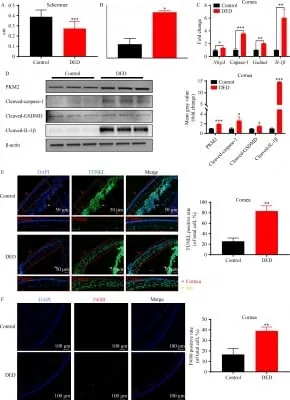
Shocking Discovery: How Hyperosmolarity Fuels Macrophage Death in Dry Eye Disease!
2025-09-03
Author: Siti
Groundbreaking Research Unveils Insights into Dry Eye Disease
In a stunning study from the Zhejiang Provincial Engineering Institute on Eye Diseases, researchers have uncovered crucial links between hyperosmolarity and inflammation in dry eye disease (DED). Featured in the prestigious journal *Frontiers of Medicine*, this groundbreaking research sheds light on a poorly understood mechanism that could revolutionize treatments for millions suffering from this painful condition.
The Heart of the Issue: How Hyperosmolarity Affects the Eye
Tear film hyperosmolarity stands at the center of DED, disrupting the delicate balance needed for a healthy ocular surface. This disruption not only instigates inflammation but also fuels cellular changes in the eye, creating a cascade of detrimental effects.
Unraveling the Complex Interplay: Glycolysis and Pyroptosis
The study dives deep into how a hyperosmolar environment sparks glycolytic reprogramming in corneal epithelial cells (HCECs). Researchers analyzed clinical samples from DED patients and found significant upregulation of genes related to glycolysis and pyroptosis, particularly the genes PKM2 and GSDMD. This upregulation leads to a surge in inflammatory markers such as IL-1β, exacerbating the condition.
The Power of 2-Deoxy-d-Glucose: A Game Changer?
Through innovative experiments involving macrophages and human corneal epithelial cells, scientists observed how high osmolarity could dramatically alter the metabolism of HCECs. Remarkably, when treated with 2-Deoxy-d-glucose (2-DG), the glycolytic activity of these cells was inhibited, leading to a significant decrease in macrophage pyroptosis. This suggests that 2-DG could be a promising therapeutic avenue, potentially alleviating DED symptoms and curtailing inflammation.
Promising Directions for Future Research
This study not only highlights the role of hyperosmolar-induced glycolytic reprogramming in promoting DED inflammation but opens the door for future research. Could targeting metabolic pathways offer a new lease on treatment? As scientists explore these connections, they ignite hopes for more effective therapies for those suffering from dry eye disease, a condition that affects countless individuals worldwide.



 Brasil (PT)
Brasil (PT)
 Canada (EN)
Canada (EN)
 Chile (ES)
Chile (ES)
 Česko (CS)
Česko (CS)
 대한민국 (KO)
대한민국 (KO)
 España (ES)
España (ES)
 France (FR)
France (FR)
 Hong Kong (EN)
Hong Kong (EN)
 Italia (IT)
Italia (IT)
 日本 (JA)
日本 (JA)
 Magyarország (HU)
Magyarország (HU)
 Norge (NO)
Norge (NO)
 Polska (PL)
Polska (PL)
 Schweiz (DE)
Schweiz (DE)
 Singapore (EN)
Singapore (EN)
 Sverige (SV)
Sverige (SV)
 Suomi (FI)
Suomi (FI)
 Türkiye (TR)
Türkiye (TR)
 الإمارات العربية المتحدة (AR)
الإمارات العربية المتحدة (AR)